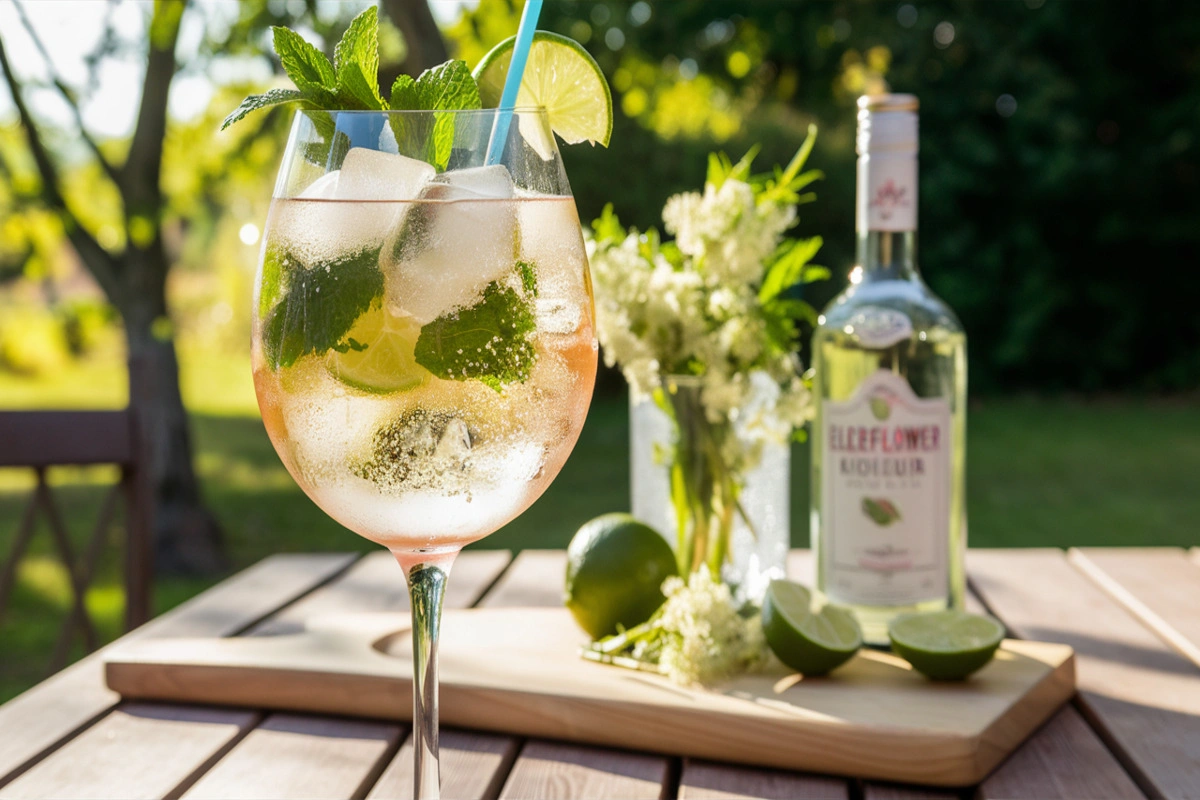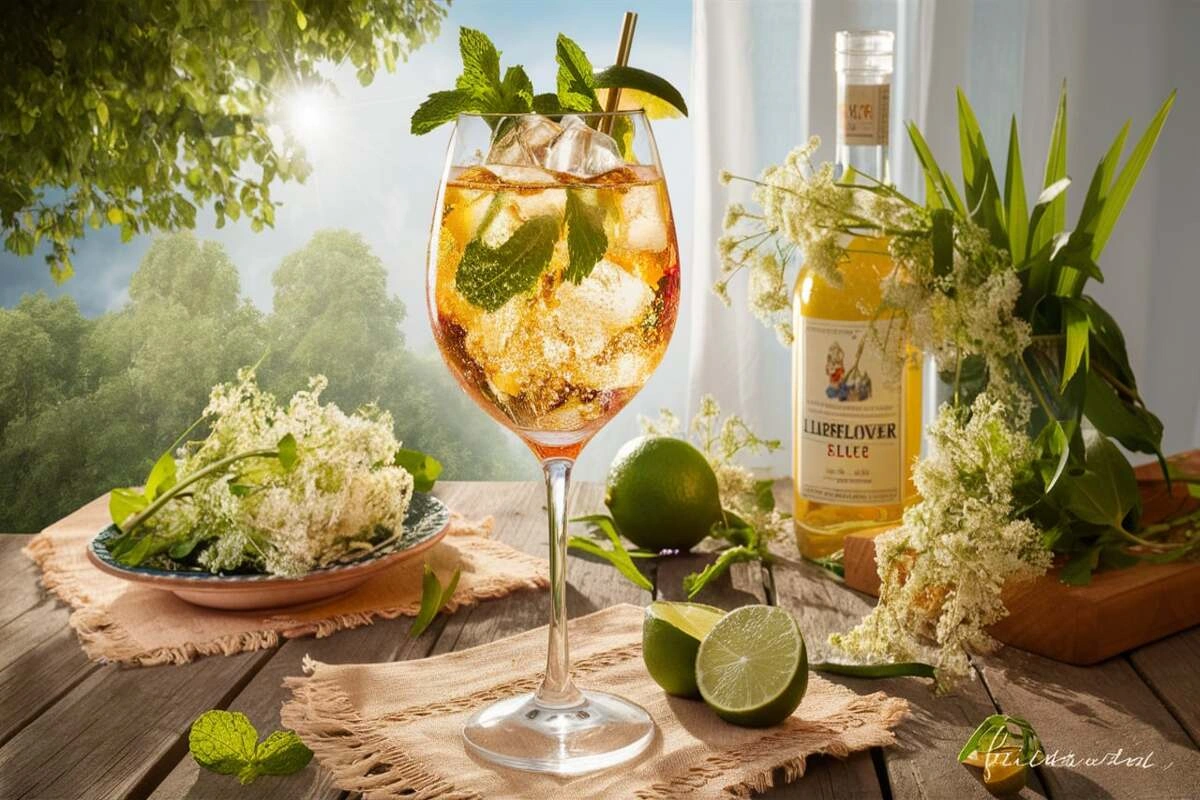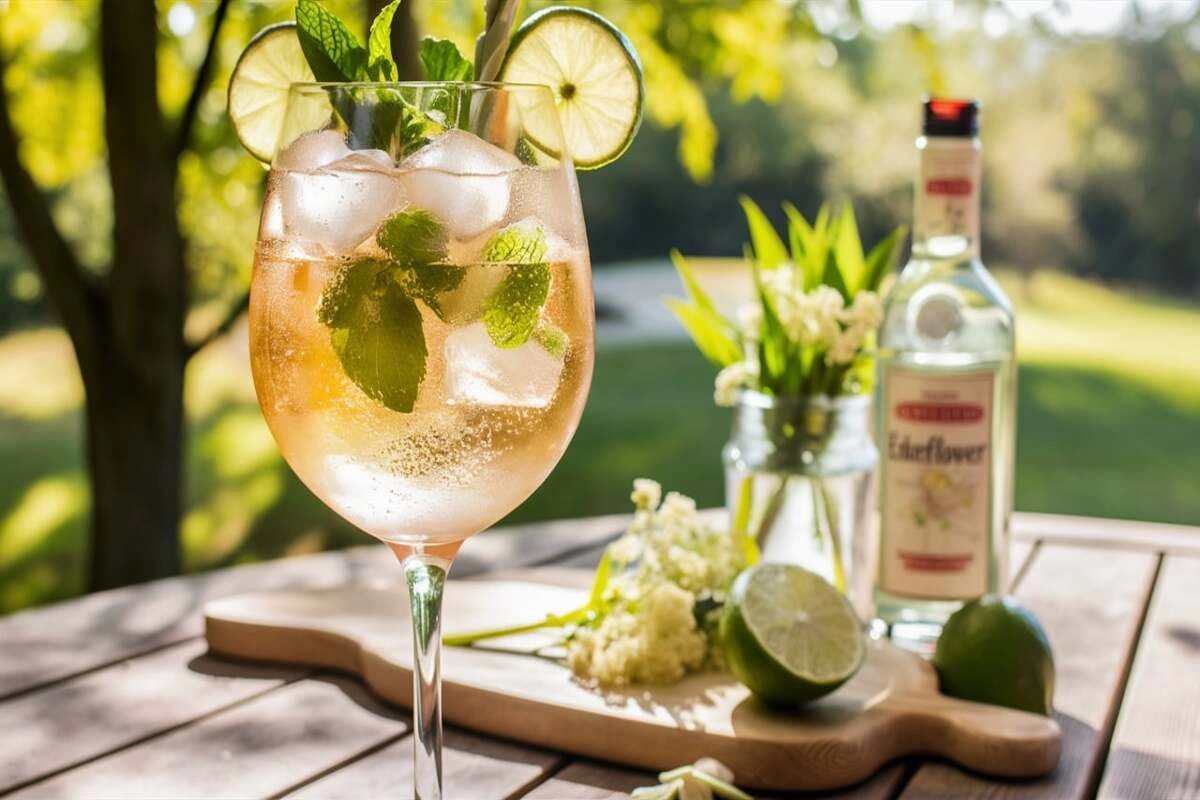The Hugo Spritz has been making waves in cocktail culture, celebrated for its light, floral notes and refreshing taste. Originating from the picturesque Italian Alps, this drink has quickly become a staple for summer gatherings and aperitif hours worldwide. In this comprehensive guide, we’ll dive deep into everything you need to know about the Hugo Spritz, from its history and origins to expert tips on crafting the perfect glass at home. We’ll also explore variations, pairing suggestions, and answer common questions about this elegant cocktail.
History and Origins
The Hugo Spritz was created in 2005 by Roland Gruber, a bartender in the northern Italian town of Naturno, near the Italian-Austrian border. Originally named “Otto,” this cocktail was designed to be a lighter alternative to the more robust Aperol Spritz. Its delicate balance of elderflower liqueur, fresh mint, and Prosecco quickly captivated locals, spreading from Austria and Germany to Italy and beyond. The drink eventually reached the U.S., where it gained popularity as a sophisticated yet approachable aperitif.
The story behind the Hugo Spritz is as intriguing as its taste. Roland Gruber was inspired to create a refreshing and aromatic cocktail that embodied the essence of summer in the Alps. The drink’s original name, “Otto,” was soon changed to “Hugo,” although the exact reason for this name change remains a mystery. What is clear, however, is that the Hugo Spritz rapidly became a favorite in Europe, thanks to its light, bubbly nature and the unique flavor profile brought by elderflower liqueur and mint.
The Hugo Spritz stands out for its lightness, both in flavor and alcohol content, making it an excellent choice for those looking for a drink that won’t overwhelm the senses. Its popularity is a testament to its perfect balance—offering a refreshing and subtly sweet experience that is easy to enjoy.
For those interested in exploring more about the history of Spritz cocktails, you might want to check out this comprehensive history of Spritz cocktails. This resource delves into the evolution of spritz cocktails, tracing their origins and how they’ve adapted over time to become the global favorites they are today.
Essential Ingredients
To craft the perfect Hugo Spritz, you’ll need just a few key ingredients. Each component plays a crucial role in creating the drink’s signature taste:
-
St-Germain Elderflower Liqueur
: This liqueur is known for its lightly sweet and floral flavor, derived from elderflower blossoms. It’s the defining ingredient of the Hugo Spritz, providing the drink’s signature aroma and taste. The subtle sweetness of the liqueur is what sets the Hugo Spritz apart from other cocktails, making it an ideal choice for those who enjoy a more delicate and refined drink.
-
Fresh Mint Sprigs
: Essential for that refreshing minty note, mint also serves as an aromatic garnish that enhances the overall drinking experience. The freshness of the mint is vital; it adds a burst of herbal flavor that complements the elderflower liqueur beautifully.
-
Prosecco
: A dry (brut) Prosecco is recommended for its crisp, light flavor that complements the sweetness of the elderflower liqueur. The bubbles from the Prosecco add an effervescent quality to the drink, making it lively and refreshing. When selecting a Prosecco, it’s essential to choose one that isn’t overly sweet, as the elderflower liqueur already provides enough sweetness.
-
Sparkling Water or Soda Water
: This adds a subtle effervescence that lightens the drink and balances the sweetness. It also helps to dilute the cocktail slightly, making it even more refreshing. The choice between sparkling water and soda water can depend on personal preference, but both serve to enhance the Hugo Spritz‘s light and airy feel.
-
Lime Wheels: Used for garnish, adding a zesty finish that cuts through the sweetness and adds a touch of acidity. The lime’s citrusy notes are the perfect counterbalance to the floral and herbal flavors in the cocktail.
These ingredients, when combined, create a harmonious blend that is both refreshing and satisfying. The interplay between the sweet elderflower liqueur, the herbal mint, and the crisp Prosecco makes the Hugo Spritz a cocktail that is both sophisticated and easy to drink.
You can also experiment with variations, such as using Rosé Prosecco for a pink Hugo Spritz or substituting white wine for a less bubbly version. And if you’re planning to serve the Hugo Spritz with a delicious appetizer, consider making a perfect cheese board to complement the drink.
For those looking to pair their Hugo Spritz with something more substantial, you might also want to explore recipes like cheesy mashed potatoes for a hearty option or tangy deviled eggs with relish for a zesty side dish.
How to Make a Classic Hugo Spritz

Creating a single Hugo Spritz is simple and can be done in just a few steps. The key to a perfect Hugo Spritz lies in the balance of ingredients and the method of preparation:
-
Prepare Your Glass: Start with a large wine glass or a highball glass. Add 1 ounce of St-Germain elderflower liqueur and two torn mint leaves. Gently muddle the mint with the back of a spoon to release its oils. This step is crucial as it helps to release the mint’s aromatic oils, which infuse the drink with a refreshing herbal note.
-
Add Ice and Prosecco: Fill the glass with a generous scoop of ice, then pour in 4 ounces of chilled Prosecco. Stir gently to mix. The Prosecco should be added slowly to avoid losing too much of its effervescence, which is a key characteristic of the Hugo Spritz.
-
Top with Sparkling Water: Pour 1 ounce of chilled sparkling water or soda water into the glass and give it a brief stir. The sparkling water not only adds bubbles but also helps to dilute the drink slightly, making it even more refreshing.
-
Garnish: Drop in a lime wheel and garnish with a sprig of fresh mint. For an extra burst of flavor, gently slap the mint on your palm before adding it to the glass. This releases the mint’s natural oils, enhancing the drink’s aroma and flavor.
For a crowd, consider making a pitcher of Hugo Spritz by scaling up the ingredients. In a large pitcher, muddle 6 ounces of St-Germain with 5-6 torn mint leaves. Add plenty of ice, pour in a bottle of chilled Prosecco, and top with sparkling water. Stir gently and garnish each serving glass with a lime wheel and mint sprig.
Advanced Tips for the Perfect Hugo Spritz
Achieving the perfect Hugo Spritz requires attention to detail, especially when it comes to the freshness of ingredients and the temperature of the drink. Here are some expert tips to ensure your Hugo Spritz is always a hit:
1. Keep Your Ingredients Chilled
The Hugo Spritz is best served cold, so be sure to chill your Prosecco, elderflower liqueur, and sparkling water before preparing the drink. This will not only enhance the refreshing quality of the cocktail but also help maintain its delicate balance of flavors. The temperature of the drink is crucial; a warm Hugo Spritz will lose its refreshing appeal.
2. Fresh Mint Matters
Mint is a crucial element in the Hugo Spritz, providing both flavor and visual appeal. To keep your mint fresh, rinse it in cool water and store it in a small ice bath or a container of water with the stems down. Right before garnishing, gently slap the mint on your palm to release its natural oils, ensuring a fragrant and flavorful garnish with every sip. Fresh mint leaves that are vibrant and green will add a pop of color to your drink, making it visually appealing.
3. Experiment with Glassware
While large wine glasses are the traditional choice for a Hugo Spritz, you can experiment with different glassware to suit your preferences or the occasion. Highball glasses or even rocks-style glasses can work well, depending on how much ice you prefer and the overall presentation you desire. The type of glass you use can also affect the drinking experience; for instance, a wider glass may allow the aromas to be more pronounced.
4. Consider the Seasonality of Ingredients
The Hugo Spritz is a drink that celebrates the flavors of summer, but it can be adapted for different seasons by incorporating seasonal ingredients. For example, in the spring, you might add a touch of elderflower syrup to enhance the floral notes, or in the fall, consider a garnish of a thin apple slice instead of lime to give the drink a seasonal twist.
5. Customize the Sweetness Level
The sweetness of the Hugo Spritz can be adjusted according to your taste preferences. If you prefer a less sweet drink, reduce the amount of elderflower liqueur or add a bit more sparkling water. Conversely, if you like a sweeter cocktail, consider adding a dash of elderflower syrup or even a splash of simple syrup. Customizing the sweetness allows you to create a Hugo Spritz that perfectly suits your palate.
6. Garnish Creatively
While the traditional garnish for a Hugo Spritz is mint and lime, don’t be afraid to get creative. Fresh berries, edible flowers, or a sprig of rosemary can add a unique twist to the presentation. These garnishes not only enhance the visual appeal of the cocktail but can also subtly influence its flavor.
Serving Suggestions and Pairings
The Hugo Spritz is best enjoyed as an aperitif, typically served before a meal or during a late afternoon gathering. Its light and bubbly nature pairs wonderfully with salty and creamy foods. Here are some pairing ideas that will elevate your Hugo Spritz experience:
-
Roasted Chickpeas
: A crunchy, salty treat that complements the drink’s effervescence. The slight nuttiness of roasted chickpeas provides a nice contrast to the sweetness of the cocktail.
-
Baked Brie with Garlic
: Creamy and rich, perfect for balancing the lightness of the Hugo Spritz. The creaminess of the Brie and the sharpness of the garlic make a delightful pairing with the floral notes of the elderflower liqueur.
-
Cheese Board: An assortment of cheeses, nuts, and fruits, making for an elegant pairing. You can learn more about how to make a perfect cheese board here. The variety of flavors and textures on a cheese board can complement the different elements of the Hugo Spritz, from the crisp Prosecco to the fresh mint.
-
Sun-Kissed Tomatoes: Italian-style, these tomatoes are lightly marinated in olive oil and herbs, offering a burst of freshness that pairs perfectly with the Hugo Spritz. The acidity of the tomatoes cuts through the sweetness of the drink, creating a balanced flavor profile.
When serving, opt for large wine glasses that allow for plenty of ice, ensuring the drink stays cold and refreshing. The choice of glassware and garnishes can significantly impact the presentation, making your Hugo Spritz even more enjoyable.
For a more substantial pairing, consider serving the Hugo Spritz with a smoked meatloaf. The smoky, savory flavors of the meatloaf can be a delightful contrast to the light, floral notes of the cocktail. The richness of the meatloaf pairs beautifully with the refreshing qualities of the Hugo Spritz, making it an excellent choice for a more robust meal.
Popular Variations of Hugo Spritz

The classic Hugo Spritz can be adapted in several ways to suit different tastes. These variations maintain the essence of the original cocktail while introducing new flavors and elements:
-
Pink Hugo Spritz: Use Rosé Prosecco instead of the regular variety for a blush-colored drink. The rosé adds a subtle berry flavor and a beautiful pink hue, making it a visually stunning variation.
-
St-Germain Spritz: A simpler version using Prosecco, St-Germain, sparkling water, and a lemon wheel for garnish. The lemon wheel adds a citrusy twist, brightening the drink and adding a slight tartness that balances the sweetness of the elderflower.
-
Non-Alcoholic Hugo Spritz: Substitute the Prosecco and elderflower liqueur with non-alcoholic sparkling wine and elderflower syrup for a delicious mocktail. This variation retains the refreshing and floral qualities of the original while making it accessible to those who prefer non-alcoholic beverages.
-
Hugo Spritz with Fruit Garnish: Add fresh fruit such as raspberries, strawberries, or blackberries to the glass for a fruity twist. The natural sweetness and tartness of the berries complement the floral notes of the elderflower, creating a more complex flavor profile.
-
Herb-Infused Hugo Spritz: Experiment with different herbs like basil, thyme, or rosemary in place of mint. Each herb will impart its unique flavor to the drink, offering a different take on the classic Hugo Spritz. Basil, for example, adds a slightly peppery note, while rosemary offers a more earthy flavor.
Each of these variations maintains the light, floral essence of the original while offering a new twist. Whether you’re looking for a sweeter, fruitier version or something with a bit more herbal complexity. there’s a Hugo Spritz variation to suit your taste.
For those looking to explore other cocktail options, you might enjoy a spicy margarita, which offers a bold, tangy alternative to the delicate Hugo Spritz. The contrast between the spicy kick of the margarita and the refreshing lightness of the Hugo Spritz can make for an exciting cocktail pairing experience.
FAQs
Who invented the Hugo Spritz?
The Hugo Spritz was invented by Roland Gruber in 2005 in Naturno, Italy. Gruber’s intention was to create a light, refreshing cocktail that could serve as a pleasant alternative to the more bitter Aperol Spritz. His creation quickly gained popularity in the region and beyond, becoming a staple in many bars and restaurants.
What is Elderflower Liqueur, and can it be substituted?
Elderflower liqueur is made from elderflower blossoms and sugar. It’s lightly sweet and floral, with a distinctive flavor that sets the Hugo Spritz apart from other cocktails. If you can’t find it, you can substitute it with elderflower syrup, though the flavor will be slightly different. The syrup is a non-alcoholic alternative that still delivers the floral notes but with a bit more sweetness. For a different twist, you could also use a liqueur like Lillet Blanc or St. Germain. which offer similar floral profiles.
Can I make a Hugo Spritz without Prosecco?
Yes, you can use white wine for a less bubbly version, or even a non-alcoholic sparkling wine for a mocktail. The key is to choose a wine that has a light, crisp flavor to complement the elderflower liqueur. If you’re using a non-alcoholic wine, consider adding a splash of soda water to maintain the effervescence that makes the Hugo Spritz so refreshing.
What are the best garnishes for a Hugo Spritz?
The classic garnishes are fresh mint and a lime wheel, but you can also experiment with other herbs like basil or lemon slices. Edible flowers, such as pansies or violets, can add a beautiful touch to the drink and enhance its floral notes. Fresh berries or a sprig of rosemary can also add visual interest and complement the flavors of the cocktail.
How can I keep the Cocktail cold for an extended period?
To keep the Hugo Spritz cold, ensure all ingredients are pre-chilled. You can also serve the drink in insulated or chilled glassware. Adding plenty of ice to the glass or pitcher will help maintain the drink’s temperature without diluting it too quickly. If you’re serving the Hugo Spritz outdoors or at a party, consider using an ice bucket to keep the pitcher chilled, or add frozen fruit to the glass, which will keep the drink cold while adding a burst of flavor.
What other cocktails are similar to the Hugo Spritz?
If you enjoy the Hugo Spritz, you might also like the Aperol Spritz, a more robust and slightly bitter cousin. The Aperol Spritz is made with Aperol, Prosecco, and soda water, and is known for its vibrant orange color and slightly bitter, citrusy flavor. For a different twist, the French 75 is another bubbly cocktail with a touch of lemon and gin. This classic cocktail offers a bit more complexity and a stronger alcohol content, making it a great choice for those who enjoy a more potent drink.
Conclusion

The Hugo Spritz is a versatile, refreshing drink that’s perfect for any occasion. Its light, floral flavors make it an excellent choice for summer afternoons, and its simplicity ensures that anyone can make it at home. Whether you stick to the classic recipe or experiment with variations. the Hugo Spritz is sure to become a favorite in your cocktail repertoire.
So why not try making your own Hugo Spritz today? Explore the different variations, pair it with your favorite snacks, and enjoy a taste of Italy with every sip. Cheers!

